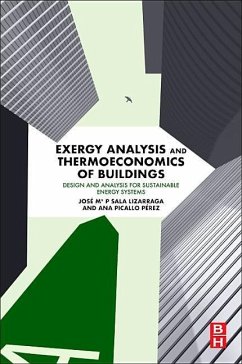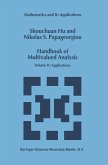Quantifying exergy losses in the energy supply system of buildings reveals the potential for energy improvement, which cannot be discovered using conventional energy analysis. Thermoeconomics combines economic and thermodynamic analysis by applying the concept of cost (an economic concept) to exergy, as exergy is a thermodynamic property fit for this purpose, in that it combines the quantity of energy with its quality factor.
Exergy Analysis and Thermoeconomics of Buildings applies exergy analysis methods and thermoeconomics to the built environment. The mechanisms of heat transfer throughout the envelope of buildings are analyzed from an exergy perspective and then to the building thermal installations, analyzing the different components, such as condensing boilers, absorption refrigerators, microcogeneration plants, etc., including solar installations and finally the thermal facilities as a whole.
A detailed analysis of the cost formation process is presented, which has its physical roots firmly planted in the second law of thermodynamics. The basic principles and the rules of cost allocation, in energy units (exergy cost), in monetary units (exergoeconomic cost), and in CO2 emissions (exergoenvironmental cost), based on the so-called Exergy Cost Theory are presented and applied to thermal installations of buildings.
Clear and rigorous in its exposition, Exergy Analysis and Thermoeconomics of Buildings discusses exergy analysis and thermoeconomics and the role they could play in the analysis and design of building components, either the envelope or the thermal facilities, as well as the diagnosis of thermal installations. This book moves progressively from introducing the basic concepts to applying them.
Exergy Analysis and Thermoeconomics of Buildings provides examples of specific cases throughout this book. These cases include real data, so that the results obtained are useful to interpret the inefficiencies andlosses that truly occur in actual installations; hence, the assessment of their effects encourages the manner to improve efficiency.
Exergy Analysis and Thermoeconomics of Buildings applies exergy analysis methods and thermoeconomics to the built environment. The mechanisms of heat transfer throughout the envelope of buildings are analyzed from an exergy perspective and then to the building thermal installations, analyzing the different components, such as condensing boilers, absorption refrigerators, microcogeneration plants, etc., including solar installations and finally the thermal facilities as a whole.
A detailed analysis of the cost formation process is presented, which has its physical roots firmly planted in the second law of thermodynamics. The basic principles and the rules of cost allocation, in energy units (exergy cost), in monetary units (exergoeconomic cost), and in CO2 emissions (exergoenvironmental cost), based on the so-called Exergy Cost Theory are presented and applied to thermal installations of buildings.
Clear and rigorous in its exposition, Exergy Analysis and Thermoeconomics of Buildings discusses exergy analysis and thermoeconomics and the role they could play in the analysis and design of building components, either the envelope or the thermal facilities, as well as the diagnosis of thermal installations. This book moves progressively from introducing the basic concepts to applying them.
Exergy Analysis and Thermoeconomics of Buildings provides examples of specific cases throughout this book. These cases include real data, so that the results obtained are useful to interpret the inefficiencies andlosses that truly occur in actual installations; hence, the assessment of their effects encourages the manner to improve efficiency.








